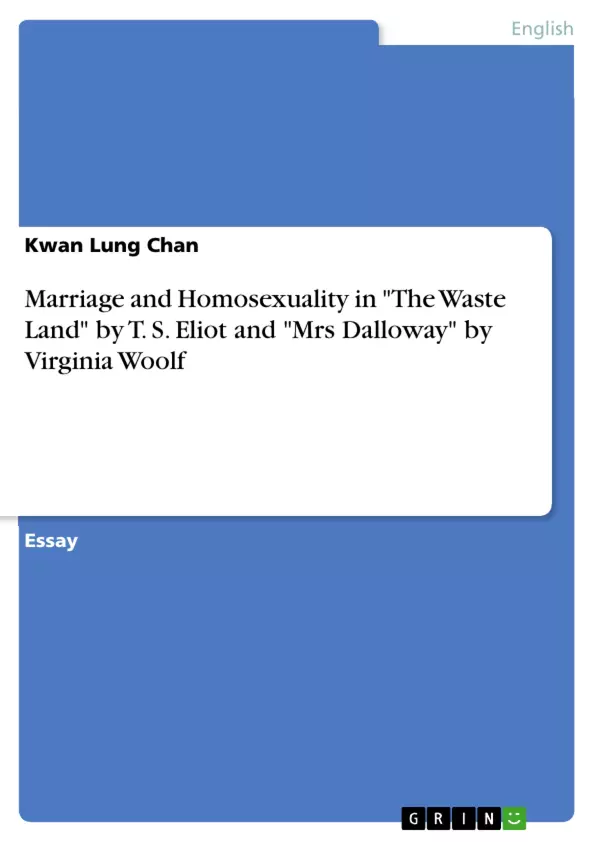In the 1920s, two pivotal literary works emerged in Britain, "The Waste Land" by T.S. Eliot and "Mrs. Dalloway" by Virginia Woolf. These novels, while sharing the same cultural milieu, diverge in their portrayal of marriage and homosexuality. This essay aims to compare how these two works explore these themes.
The 1920s witnessed two influential movements shaping marriage trends in Britain. The eugenics movement urged careful partner selection for better offspring, while the motherhood campaign encouraged marriage to address post-World War I male depopulation. This era can be characterized by a marriage paradox, where both unions and divorces were prevalent.
In "The Waste Land," specifically in its second section, "A Game of Chess," a wealthy married couple's relationship deteriorates due to ethical breakdown. Despite their opulent surroundings, the husband's fixation on physical desires erodes their connection. Eliot's vivid descriptions and the transition from a tapestry depicting Philomela's rape to a sensual encounter highlight the couple's crumbling relationship, emphasizing the theme of ethical decay in marriages.
In "The Waste Land," marriage disintegrates due to ethical degradation, particularly the selfish prioritization of sexual needs. Conversely, "Mrs. Dalloway" presents marriage in a positive light. Clarissa, married to Richard, harbors affection for Sally Seaton. Their passionate kiss is described as life's pinnacle moment. Clarissa's marriage to Richard, though pragmatic, offers support, societal success, and personal contentment.
In "Mrs. Dalloway," marriage is portrayed as a solution to personal and societal challenges, including psychological distress. This contrasts with "The Waste Land," where marriages are fraught with problems when emotional intimacy is neglected. These two works encapsulate the contrasting philosophies of 1920s Britain regarding marriage.
In terms of representation, "The Waste Land" employs explicit sexual imagery to underscore the gravity of ethical breakdown in marriages fixated on physical gratification. In contrast, "Mrs. Dalloway" presents marriage as an objective subject of societal discourse, emphasizing the importance of personal space within the union. These two iconic literary works reflect the divergent narratives that characterized 1920s Britain's perspectives on marriage and homosexuality.
Table of Contents
- Marriage and Homosexuality in “The Waste Land” and “Mrs Dalloway”
- Marriage in The Waste Land
- Marriage in Mrs Dalloway
- Homosexuality in The Waste Land
Objectives and Key Themes
This essay explores the representation of gender issues, particularly marriage and homosexuality, in two prominent literary works of 1920s Britain: “The Waste Land” and “Mrs Dalloway.” It analyzes how these works reflect contrasting perspectives on marriage, drawing parallels between the texts and prevailing social movements of the time.
- Marriage in 1920s Britain: Exploring the contrasting philosophies of the pro-divorce eugenics movement and the pro-marriage motherhood campaign.
- Ethical Breakdown in Marriage: Analyzing how The Waste Land portrays marriage as a source of problems due to selfishness and a focus on sexual needs over emotional connection.
- Marriage as a Solution: Exploring how Mrs. Dalloway presents marriage as a means of achieving social stability and personal fulfillment, particularly for women.
- Homosexuality in The Waste Land: Examining the negative portrayal of homosexuality and its connection to themes of ethical breakdown and societal anxieties.
- Gender Roles and Social Expectations: Analyzing how both texts reflect the changing gender roles and social expectations of 1920s Britain.
Chapter Summaries
The essay begins by examining the contrasting perspectives on marriage presented in "The Waste Land" and "Mrs Dalloway." "The Waste Land" depicts a deteriorating marital landscape, with the rich couple in "A Game of Chess" demonstrating the breakdown of ethical boundaries in relationships, characterized by self-centeredness and a focus on sexual gratification. This portrayal echoes the anxieties of a society grappling with the "marriage paradox," where divorce rates rose alongside the pressures to marry and reproduce.
In contrast, "Mrs Dalloway" presents marriage as a solution to various societal challenges. Clarissa's marriage to Richard, while not based on love, provides stability and social standing, allowing her to host extravagant parties. The novel suggests that even amidst social and psychological turmoil, marriage can offer a sense of order and security.
The essay concludes its analysis by focusing on the portrayal of homosexuality in "The Waste Land." Drawing on literary scholarship, the author argues that Eliot's portrayal of homosexuality as a "threat" reflects a Freudian concept of unconscious masochistic fantasies, suggesting a desire for male love and a rejection of the traditional heterosexual dynamic.
Keywords
This essay focuses on key gender issues in 1920s Britain, particularly the complex representation of marriage and homosexuality. It delves into themes of ethical breakdown, social anxieties, changing gender roles, and the impact of social movements like eugenics and the motherhood campaign on literary portrayals. Key figures examined include T.S. Eliot, Virginia Woolf, and prominent figures from the era like Philomela and Tereus.
- Citar trabajo
- Kwan Lung Chan (Autor), 2019, Marriage and Homosexuality in "The Waste Land" by T. S. Eliot and "Mrs Dalloway" by Virginia Woolf, Múnich, GRIN Verlag, https://www.grin.com/document/906419



